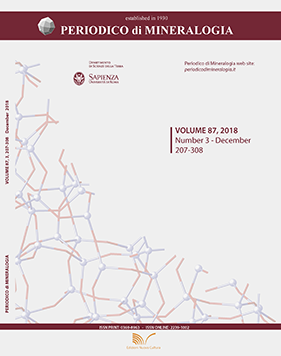Geochemistry of Paleozoic Dadaş Shales from the Foreland of Southeastern Turkey, Bismil, Diyarbakır
DOI:
https://doi.org/10.2451/2018PM683Keywords:
Paleozoic, Dadaş Shales, provenance, climatic conditions, southeastern TurkeyAbstract
The Early Silurian-Early Devonian Dadaş Shales composed of sandstone-banded, carbonate-interbedded, organic material-rich dark colored shales are one of the largest oil source rocks in southeastern Turkey. The sediment geochemistry, along with mineralogical investigations of two drill hole samples from Dadaş Shales have been carried out in order to understand their provenance, paleoweathering, paleoredox, paleoclimate and tectonic conditions. Samples are mainly composed of feldspars, quartz, clay minerals (illite, kaolinite), calcite and dolomite. All the samples exhibit high values of the mudrock maturity index (MMI), and chemical index of alteration (CIA) indices reflects that recycling processes have been important in homogenizing the composition of Dadaş Shales. The C-values of Dadaş Shales show mainly moist climatic conditions prevailed in Dadaş Shales during Paleozoic time. Ni/Co vs. V/Cr, U/Th and Cu/ Zn, Ce/Ce* ratios yielded oxic conditions for deposition in investigated samples. Al2O3/(Al2O3+Fe2O3+MnO), Th/U, Rb/Sr, La/Ni, Cr/Th, La/Yb, Eu/Eu*, (La/Yb)N, (Gd/Yb)N ratios and the chondrite-normalized REE patterns of the Dadaş Shales are also similar to that of Post Achaean Australian Shale (PAAS), indicating that they were derived from a differentiated silicic sedimentary rock. Compositional maturity of analyzed samples is conformable with continental margin and continental arc island formations.
The Early Silurian-Early Devonian Dadaş Shales composed of sandstone-banded, carbonate-interbedded, organic material-rich dark colored shales are one of the largest oil source rocks in southeastern Turkey. The sediment geochemistry, along with mineralogical investigations of two drill hole samples from Dadaş Shales have been carried out in order to understand their provenance, paleoweathering, paleoredox, paleoclimate and tectonic conditions. Samples are mainly composed of feldspars, quartz, clay minerals (illite, kaolinite), calcite and dolomite. All the samples exhibit high values of the mudrock maturity index (MMI), and chemical index of alteration (CIA) indices reflects that recycling processes have been important in homogenizing the composition of Dadaş Shales. The C-values of Dadaş Shales show mainly moist climatic conditions prevailed in Dadaş Shales during Paleozoic time. Ni/Co vs. V/Cr, U/Th and Cu/ Zn, Ce/Ce* ratios yielded oxic conditions for deposition in investigated samples. Al2O3/(Al2O3+Fe2O3+MnO), Th/U, Rb/Sr, La/Ni, Cr/Th, La/Yb, Eu/Eu*, (La/Yb)N, (Gd/Yb)N ratios and the chondrite-normalized REE patterns of the Dadaş Shales are also similar to that of Post Achaean Australian Shale (PAAS), indicating that they were derived from a differentiated silicic sedimentary rock. Compositional maturity of analyzed samples is conformable with continental margin and continental arc island formations.


